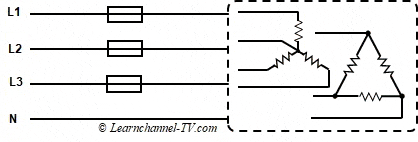English
Deutsch
Português
Español
- Electrical engineering
- Voltage Current Resistance
- Star Delta Transformation
- Practical Voltage and Current Sources, equivalent circuit diagram
- Capacitor to DC voltage
- Inductors in DC Circuits
- Alternating current
- AC Inductive Circuits
- Three-phase Current
- Transformer
- Complex numbers
- Locus Diagram in AC circuits
- Measurement error
- Videos electrical engineering
- Index electrical engineering
Home ⇒ Overview Courses ⇒ Electrical engineering ⇒ Three-phase Current ⇒ Three-Phase fault – Phase Loss
Three-phase fault - phase loss – failure caused by a burned resistor
In a three-phase system, the following question arises often: What happens in case of a blown fuse, broken wire, worn contact or a resistor burned due to thermal overload?
We consider these error possibilities for star and delta connection at a usual line voltage of 480 V. All string resistors have the same value - thus the connected load is symmetrical. To keep the calculation simple, all string resistors have a value of 10Ω.

Three-phase fault - phase failure or failure of a string resistor
Take a closer look at the star connection
In general, the following applies to the star connection: It does not matter whether a resistor of the load (string) or a fuse in the supply line blows - the consequence is the same, because in the star connection the current in the line is equal to the current through the resistor (Line current ILine = resistor current ILoad).
3 Phase fault - Star connection with one phase loss

3 Phase fault - Phase loss at a Star connection with a neutral line
If you redraw the star connection, you can see that it is basically a parallel connection of two resistors, each connected to 480 V/√3 = 277 V.
I case of a phase fault, the new power is reduced to:
Pnew = 2/3 POriginal
Since the remaining 2 currents no longer cancel each other out in the star point, the load now becomes asymmetrical, i.e. a current flows through the neutral conductor.
3 Phase fault - Star connection with loss of 2 out of 3 phases

3 Phase fault - Loss of 2 out of 3 phases at a Star connection with a neutral
Now that two of the three resistors are gone, only 1/3 of the original power remains. The neutral conductor now carries the same current as the remaining phase.
Pneu = 1/3 Poriginal
3 Phase fault - Star connection with Phase loss and loss of the neutral line

3 Phase fault - Phase loss and loss of the neutral line at a Star connection
From the equivalent circuit you can see that now the circuit has changed to a series connection of two resistors, which are connected to a common voltage of 480 V. The total power is now calculated to:
Porginal = 3 × (480V)2 / 10Ω = 23.04 kW
Pnew = V2 / Rtot = (480V)2 / 20Ω = 11.52 kW
Thus: Pnew = 0.5 Porginal
Take a closer look at the Delta connection
With the Delta connection, the voltage at the resistor is equal to the line voltage. A neutral conductor is omitted for the delta connection. We consider possible errors:
3 Phase fault - Delta connection - failure of a resistor

3 Phase fault - Delta connection - failure of a resistor
The load resistors are independent of each other, i.e. if one resistor fails, the others are not affected.
Thus, the following applies: Pnew = 2/3 Poriginal
Phase fault - Delta connection - phase failure with defect resistor connected to

3 Phase fault - Delta connection - phase failure with defect resistor connected to
The remaining resistor is still connected to 480 V line voltage. This means that the current through this resistor also remains the same.
Thus, the following applies: Pnew = 1/3 Poriginal
3 Phase fault - Delta connection - failure of one phase

3 Phase fault - Delta connection - failure of one phase
The equivalent circuit shows that a resistor network of three resistors is connected to a phase voltage, here 480 V. We calculate:
Rtot = (R1 + R2) II R3 = 20Ω x 10Ω / (20Ω + 10Ω) = 6.67 Ω
Thus the total power: P = V2/Rtot = (480V)2 / 6,67 Ω = 34.54 kW
Original power: Porginal = 3 x V2/R = 3 x (480V)2 / 10Ω = 69.12 kW
Thus: Pnew = 1/2 Poriginal
3 Phase fault - Delta connection - phase failure with defect resistor connected to

3 Phase fault - Delta connection - phase failure with defect resistor connected to
As the equivalent circuit shows, there is only one current-carrying resistor, which is connected to the line voltage. This gives the new power:
Pneu = 1/3 Poriginal
3 Phase fault - Delta connection - phase failure with defect resistor not connected to

3 Phase fault - Delta connection - phase failure with defect resistor not connected to
Two resistors in series are connected to an external conductor voltage of 400 V. This results in a total power:
Pnew = V2 / Rnew = 4802V2 / 20Ω = 11.52 kW
Rnew = R1 + R2 = 10Ω + 10Ω = 20Ω
=> Pneu = 1/6 Poriginal

